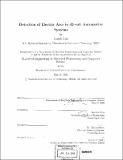| dc.contributor.advisor | Markus Zahn and Thomas Keim. | en_US |
| dc.contributor.author | Luis, Joseph, 1980- | en_US |
| dc.contributor.other | Massachusetts Institute of Technology. Dept. of Electrical Engineering and Computer Science. | en_US |
| dc.date.accessioned | 2006-03-24T16:14:14Z | |
| dc.date.available | 2006-03-24T16:14:14Z | |
| dc.date.copyright | 2003 | en_US |
| dc.date.issued | 2003 | en_US |
| dc.identifier.uri | http://hdl.handle.net/1721.1/29676 | |
| dc.description | Thesis (M.Eng.)--Massachusetts Institute of Technology, Dept. of Electrical Engineering and Computer Science, 2003. | en_US |
| dc.description | Includes bibliographical references (p. 139-140). | en_US |
| dc.description.abstract | The increasing demand of electrical power in today's automobile has led to the research and development of a new 42 V standard. One danger at this new voltage is stable electrical arcing. At the higher voltage, stable electric arcs do not self extinguish and can cause damage to the arcing conductors and cause a fire. This work evaluates possible methods to use to detect and stop electrical arcing before any major damage can occur to the vehicle and more importantly to the passengers. Electronic detection is proposed as the best approach. Arcing current of stable and unstable arcs at ~42 V and ~14 V are produced by the rebuilt apparatus of a previous MIT experiment that used a motor controlled mechanical switch to periodically energize a conductor to produce stable and unstable arcs. Fourier analysis is performed on the measured current waveforms to look for arc signatures in the frequency domain. Fourier analysis on the average of ten spectra of stable arcs showed that there were no consistent features universally present in stable arcs. Current waveforms of real electrical loads are also measured using electrical accessories (windows,door locks, seat adjustment, lights, sunroof, CD changer, radiator cooling fan) on an electrically operational 1997 Mercury Sable and the amplitudes of their frequency spectra are compared to the amplitude of the average arcing spectrum. It is determined that although some electrical loads have recognizable shapes in the frequency domain, the amplitudes of the spectra of the loads and the arcs are of the same order. It is concluded that additional research and development is needed for an improved electronic detection approach to detect and identify electric arcs in 42 V automotive systems. | en_US |
| dc.description.statementofresponsibility | by Joseph Luis. | en_US |
| dc.format.extent | 140 p. | en_US |
| dc.format.extent | 5557131 bytes | |
| dc.format.extent | 5556940 bytes | |
| dc.format.mimetype | application/pdf | |
| dc.format.mimetype | application/pdf | |
| dc.language.iso | eng | en_US |
| dc.publisher | Massachusetts Institute of Technology | en_US |
| dc.rights | M.I.T. theses are protected by copyright. They may be viewed from this source for any purpose, but reproduction or distribution in any format is prohibited without written permission. See provided URL for inquiries about permission. | en_US |
| dc.rights.uri | http://dspace.mit.edu/handle/1721.1/7582 | |
| dc.subject | Electrical Engineering and Computer Science. | en_US |
| dc.title | Detection of electric arcs in 42-volt automotive systems | en_US |
| dc.type | Thesis | en_US |
| dc.description.degree | M.Eng. | en_US |
| dc.contributor.department | Massachusetts Institute of Technology. Department of Electrical Engineering and Computer Science | |
| dc.identifier.oclc | 53833851 | en_US |
